
Our Lady of Lourdes Catholic Church is a Roman Catholic parish church of the Archdiocese of Saint Paul and Minneapolis located in Minneapolis, Minnesota in the United States. It was built on the east bank of the Mississippi River in today's Nicollet Island/East Bank neighborhood; it is the oldest continuously used church building in the city and is part of the St. Anthony Falls Historic District.

The Washburn-Fair Oaks Mansion District is a historic district in the Whittier neighborhood of Minneapolis, Minnesota, United States, centered on Washburn-Fair Oaks Park. The city of Minneapolis designated a district bordered by Franklin Avenue, Fourth Avenue South, 26th Street East, and First Avenue South. A smaller district, listed on the National Register of Historic Places, includes seven mansions along and near 22nd Street East.

This is a list of the National Register of Historic Places listings in Otter Tail County, Minnesota. It is intended to be a complete list of the properties and districts on the National Register of Historic Places in Otter Tail County, Minnesota, United States. The locations of National Register properties and districts for which the latitude and longitude coordinates are included below, may be seen in an online map.

Park Region Luther College is a former educational institution in Fergus Falls, Minnesota. The college's main building is listed on the National Register of Historic Places. It is now occupied by Hillcrest Lutheran Academy, a private Christian junior high and boarding high school.

Sennett and Bertha Kirk House is a 1913 Colonial Revival house in Garnett, Kansas, United States. The house was listed on the National Register of Historic Places (NRHP) in 2005. In 2017, the house is operated as The Kirk House, a bed and breakfast.

Edward Townsend Mix was an American architect of the Gilded Age who designed many buildings in the Midwestern United States. His career was centered in Milwaukee, Wisconsin, and many of his designs made use of the region's distinctive Cream City brick.

The Harvey H. Cluff house is a house in central Provo, Utah, United States, built in 1877 that is on the National Register of Historic Places. It was originally owned by Harvey H. Cluff.

The Fergus Falls Regional Treatment Center is a former hospital located in Fergus Falls, Minnesota. It was built in the Kirkbride Plan style and first opened to patients in 1890. Over the next century it operated as one of the state's main hospitals for the mentally ill and also worked with people with developmental disabilities and chemical dependency issues. It was added to the National Register of Historic Places in 1986.

The W.E. Barnard House, at 950 Joaquin Miller Dr. in Reno, Nevada, United States, was built in 1930. It includes Tudor Revival architecture, and, within that, is best described as a Cotswold Cottage style small house. Its two most dominant architectural features are a beehive chimney and a "high-pitched, gabled entry with a characteristic Tudor arch".

The Aiken Stand Complex is a historic pair of buildings at the junction of Royalton Turnpike and Sayer Road in rural Barnard, Vermont. Built c. 1805 and 1835, they were the centerpiece of a small village that flourished in the first half of the 19th century, when the Turnpike was the principal north–south route through the region. The buildings were listed on the National Register of Historic Places in 1983.
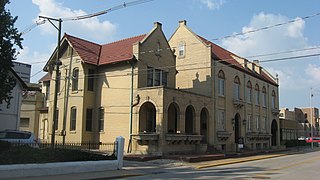
Robert Smith Mortuary, also known as the Greek-Shears Mortuary, is a historic mortuary building located in downtown Evansville, Indiana. It was built in 1930, and is a 2+1⁄2-story, rectangular Mission Revival style brick building. It features arcaded windows, an esplanade, and steeply pitched red tile roof. It is connected to a 2+1⁄2-story brick former dwelling constructed about 1890 and remodeled in 1930 to complement the new building.

The Harper and McIntire Company Warehouse, also known as Smulekoff's Warehouse, is a historic building located in Cedar Rapids, Iowa, United States. Harper and Mcintire was a wholesale hardware business that was established in Ottumwa, Iowa in 1856. A branch warehouse in Cedar Rapids was begun in 1921. The four-story, brick, Commercial structure was designed by the Minneapolis architectural firm of Croft and Boerner. Cedar Rapids contractor Theodore Stark & Company and Ferro Concrete Construction Company of Cincinnati were responsible for construction. The building was completed in 1922 in an industrial area where spur lines connected it to the Fourth Street Railroad Corridor. It was originally designed as a seven-story building, but by the time it was put out for bid it was reduced to four-stories with a two-story tower that enclosed a water tank. Two additions were added to be building that facilitated the change to shipping by truck. The east side addition was completed in the 1940s, and the west side addition (1962) was built where the railroad spur track had been located. Smulekoffs Furniture Company took over the building in 1981 and remained until 2014 when they went out of business. The building was listed on the National Register of Historic Places in 2015.

The C.C. Clement House is a historic building located in Fergus Falls, Minnesota, United States. Completed in 1882, the design of the 2½-story frame house was attributed to Fargo architect Charles N. Daniels. The picturesque Stick style dwelling features a steep gabled roof with jerkin head and eave bracing. Also indicative of the style is the articulation of the wall surfaces by panel divisions with vertical and diagonal forms that suggest the structural frame underneath. Stick decorative elements are found in the pierced eave boards, the porch frieze with a saw-tooth edge and cut-out panels, turned posts and the floral design panels on the tower. The house was built by C.C. Clement who managed the interests of George B. Wright, one of the original developers of Fergus Falls. It remained in the Clement family until 1948 when it was sold to Wendell Hubers. The house was listed on the National Register of Historic Places in 1986.
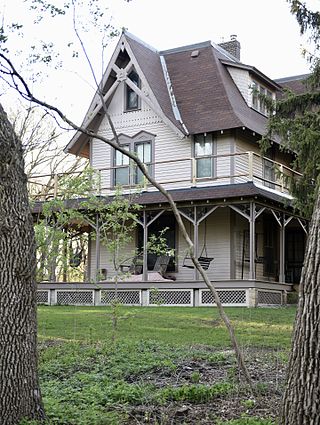
The C.J. Wright House is a historic building located in Fergus Falls, Minnesota, United States. Minneapolis architect Leroy S. Buffington supplied the designs for this 2½-story wood frame residence. Isaac H. Hobbs & Son, architect firm from Philadelphia created the house drawings. Local carpenter J.O. Crummett built it from 1881 to 1882. Construction began under the direction of George B. Wright and completed by his nephew C.J. Wright. The Wrights were Vermont natives who surveyed and were involved in developing the new town of Fergus Falls. The Queen Anne style structure follows an irregular plan. It is also a Stick style variant of the Gothic Revival style. The Gothic Revival is found in the scissor-trusses with an eight-pointed star medallion on each of the gables and the scroll-sawn spandrels of the wrap-around front porch. The house was listed on the National Register of Historic Places in 1978. The house has seen 6 generations of continuous family ownership.
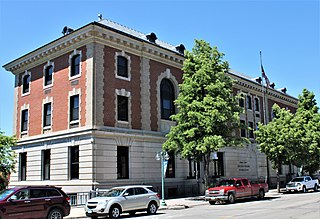
The Edward J. Devitt U.S. Courthouse and Federal Building is a historic post office and courthouse building located in Fergus Falls, Minnesota, United States. It is used as a courthouse for the United States District Court for the District of Minnesota. The building was designed by Supervising Architect of the United States Department of the Treasury James Knox Taylor. The three-story steel-frame structure was completed in 1904 in the Renaissance Revival style. The exterior is composed of granite, brick, and limestone. The interior lobby has a floor of marble and terrazzo. The building was expanded in 1927 and 1933, which nearly doubled its size. Because of poor hotel accommodations in Fegus Falls, the federal courthouse was almost relocated to Detroit Lakes in the late 1920s. The River Inn was completed across the street in 1929, and it provided accommodations for judges, jurors, lawyers, and court visitors for many years. The building was listed on the National Register of Historic Places in 2012. The following year it was named for Edward James Devitt, who served in the United States House of Representatives from 1947 to 1949, and as the Chief Judge of the U.S. District Court of Minnesota from 1959 to 1981.

River Inn is a historic building located in Fergus Falls, Minnesota, United States. This was the third of three first-class hotels built in the central business district. Completed in 1929, it replaced the Hotel Kaddatz as the city's premier hotel. It also assured that the Federal Courthouse, located across the street, did not relocate to Detroit Lakes in the 1920s. The River Inn provided accommodations for judges, jurors, lawyers, and court visitors. Boston architect Vernon A. Wright developed the hotel and designed the building. His father was George B. Wright, one of the city's founders. Vernon Wright also co-founded the Otter Tail Power Company. The four-story brick structure with Indiana limestone trim, features elements of the Medieval Revival style, the only commercial building downtown in that style. It was built by the Lauritzen Construction Company. While owned by Wright until his death in 1938, the hotel was managed by the Roberts Hotel Chain of Winona, Minnesota. The building was extensively renovated after Al C. Kavli acquired the property in 1965, reducing the number of rooms from 96 to 15 and converting the rest into apartments. It was listed on the National Register of Historic Places in 1988.
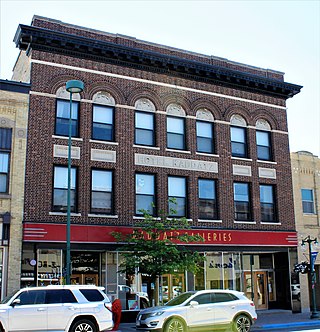
Hotel Kaddatz, also known as the Hotel Wm. Barkley, is a historic building located in Fergus Falls, Minnesota, United States. Charles W. Kaddatz settled in town in 1886. He was involved in various commercial ventures when he started construction on the hotel in 1914. Completed the following year, it assured that the Federal Courthouse did not leave Fergus Falls. The hotel provided accommodations for judges, jurors, lawyers, and court visitors. It was eventually eclipsed by the River Inn as the city's premier hotel. The three-story dark brick structure was designed by Fargo architect George Hancock in the Renaissance Revival style. It featured 75 guest rooms, 30 of which had a private bath, sample rooms, and a restaurant. There was an annex across the alley that was accessed by a tunnel and an overhead enclosed bridge. It was condemned in 1981 and torn down. The hotel's name was changed to Hotel Wm. Barkley sometime after Barkley bought the hotel in 1920. The first floor was renovated about 1936 for retail purposes and the hotel lobby was reduced in size. In 1940 the Scott-Burr department store occupied the first floor. It is now an art gallery. The building was listed on the National Register of Historic Places in 1983.
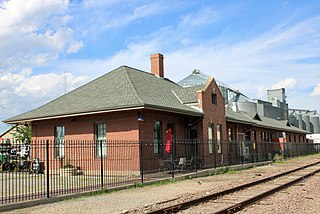
Fergus Falls station is a historic building located in Fergus Falls, Minnesota, United States. It was listed on the National Register of Historic Places in 2022 as the Northern Pacific Depot.
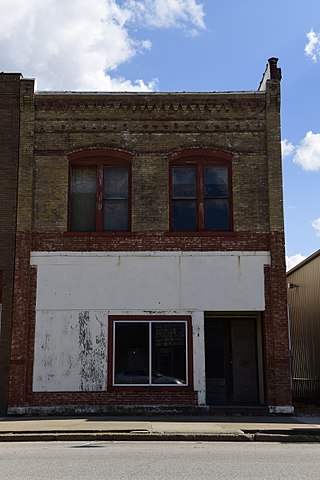
The Ramsey Building is a historic building located in Keota, Iowa, United States. Eben J. Ramsey had the two-story, brick, Romanesque Revival commercial building constructed in 1895. Its significance is derived from its association with both the furniture and funeral business. Ramsey had both businesses in the building until 1907. He had to partially rebuild it after a fire in 1897. A furniture store continued to occupy the building until 1957. A funeral home was located here until 1937 when it was relocated to a house. This marked the separation of a business marketing goods with one that provided services. At the same time, the furniture store merged with the new appliance store, which represented a sift to selling traditional furnishings with modern conveniences for the home. The building was listed on the National Register of Historic Places in 2017.





















